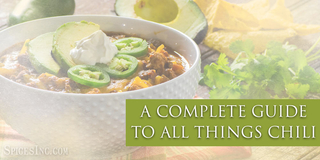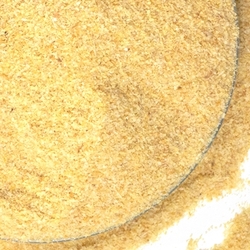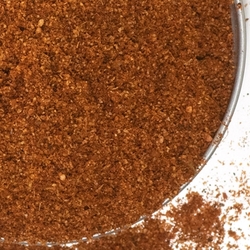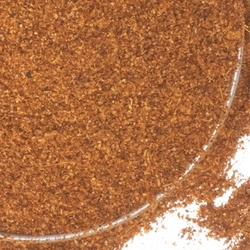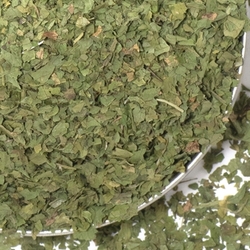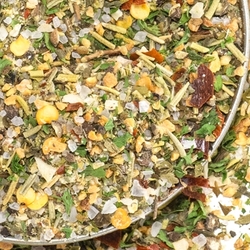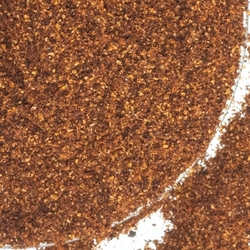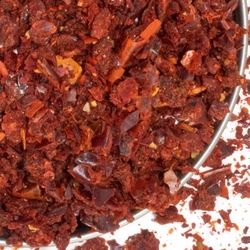A Complete Guide to All Things Chili
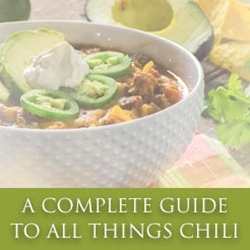
It's a little chilly outside and you've decided you want to eat something warm and cozy for dinner… chili it is! Chili recipes are as plentiful as there are stars in the sky. There are so many aspects to creating a truly memorable bowl of chili. What peppers should you choose to flavor your chili? Do you like to stick with classic chili flavors? Do you dare to try a seasoning that's unexpected, but can become a secret weapon? Perfecting the art of chili takes time and attention on your part, though the odds are in your favor that you still won't mind eating the mistakes. This guide to all things chili will help you craft your own original bowl, or teach you how to perfect a fan favorite chili recipe from that dog-eared recipe book you've got tucked away in your cabinet.
Where did Chili Come From?
The origins of chili are cloaked in mystery. While it seems most likely that it originated with a group of Canary Islanders who settled in the San Antonio area of Texas in the late 1700s, the romantic allure of cowpokes cooking a bowl of red under the stars on cattle drives has lasting and imaginative appeal. It is fairly certain that no matter what group brought chili into being, they were located in Texas, and chili still holds a special place for Texans to this day.
Texas legend says that the first evidence of chili in a commercialized setting comes from the Chili Queens of San Antonio. These women set up carts or trailers in Military Plaza and sold seasoned meat stews that came to be known as "chili". Makeshift tables and chairs were set out for diners and small lanterns would illuminate the carts. While the descendants of the Chili Queens insist that these women sold chili in this area for 200 or more years, only the last third of that history has any physical record- the kitchens and memories of these women being lost to time and word-of-mouth tales. Chili Queens are credited for crafting chili into what we know as chili now, with their use of highly seasoned meat in a delicious, thick tomato base with lots of chiles for their heat. Competition for customers was stiff, even as the nights grew longer and people came in from all over the place to get some Chili Queen chili. This led to new, better, spicier recipes being turned out at a quick rate to ensure that their cart was the most popular on the plaza. This way of chili creation and consumption was halted in the 1930s when the health department shut down every Chili Queen stand. Luckily by then chili had become a popular dish across the country and was no longer limited to the Military Plaza.
Beans or No Beans?
There are food debates that span both decades and states here in the USA. The pizza debate between New York City and Chicago is nothing short of legendary. The "who does barbecue best?" question is pretty much universally unanswered because there are at least four cities that are adamant that they are the source of the best barbecue. Beans in chili is the last of our three most prominent food debates listed here. Some people get angry when you suggest that beans go in chili, others shrug. It's not that important to them. Beans have a place in chili's history, so it's worth exploring this tiny food as an option.
The Chili Queens were shut down in the early 1930s, right when the Great Depression in the United States was taking its toll on the economy. Inexpensive and delicious, chili was a way people survived this particular period of history. These parlors offered a place for the less fortunate to go and enjoy a hearty meal that would keep them full for a long time at a cheap price. Enter beans. Full of protein and fiber, beans were a logical addition to chili in this time of extreme financial duress. As they added texture and mass to the usual chili recipe, this choice was the most cost-effective for the shop owners as well, who would use this very inexpensive ingredient to bulk up their recipes.
Today, our economic standing is a little better, meaning we don't have to use beans to bulk up our chili. However, there are still plenty of people who do so simply for the joy that beans bring to a dish. The definition of chili is "a spicy dish made of ground beef, hot peppers or chili powder, and usually beans." There is no clear answer here to the "beans or no beans" question. Usually beans, but sometimes not, and it's still considered chili! Dictionaries probably just don't want any beef, no pun intended. You might even throw yourself into the "is vegetarian chili even really chili?" debate, but that's basically the same argument if you think about it. It comes down to replacing the meat in a recipe with beans, and as mentioned before this is a pretty heated debate.
Plenty of chili recipes were made without a written recipe, using ingredients that were immediately available. Tough cuts of meat needed to cook for hours, making them perfect for chili. Now, we use whatever cuts of meat we want! Beans or no beans? The choice is up to you. How you feel about beans in chili may even be influenced by where you live, or just the chili recipes you grew up on. Just be sure to serve soda or oyster crackers with your chili! They are necessary for an authentic chili-based meal.
Is There a Right Way to Make Chili?
There's not a "right way" to make chili, as there are hundreds of variations and ingredients that can be added. Several variations of popular chilis from across the country show that chili can be whatever you want it to be.
The Texas Bowl of Red is flavored with meat and chiles only. Beans are an absolute no go with this type of chili.
New Mexican Green Chile Stew is made with New Mexican grown chiles, some of the most desired and sought after chiles in the chilehead sphere. This Green Chile Stew is a beef and tomato-based chili. Sometimes it has beans, sometimes it doesn't, but the key ingredient here is the green chile that must be grown in New Mexico. It's a holiday favorite that reminds plenty of New Mexicans of home.
Cincinnati Chili is a complex type of chili. It can be served in five different ways that include a combination of chili, spaghetti, shredded cheddar cheese, chopped onions, and beans. You may also discover your chili contains allspice, cinnamon, or chocolate in the ingredients list! When ordering your chili, you say it like this, depending on what you want in your chili.
- Bowl: chili in a bowl
- Two-way: chili and spaghetti
- Three-way: chili, spaghetti, and cheese
- Four-way: chili, spaghetti, cheese, and onions
- Five-way: chili, spaghetti, cheese, onions, and beans
- The Michigan Coney Hot Dog is chili with a conflicting background. Coney Island restaurants in both Jackson and Detroit claim this hot dog and chili style to be their own. It's an all-natural beef hot dog topped with all meat chili, chopped white onions, and yellow mustard. This staple is popular in Jackson, Flint, Detroit, and Southeast Michigan.
How to Make Chili Healthier?
Chili isn't a health food, but it can be made healthier with just a few adaptations or ingredient swaps.
- Use herbs and spices to help intensify your flavors. Chili powders are pre-made spice blends that can help new cooks or chefs on a time crunch add a huge amount of flavor without much effort. Learning to build flavors is an important part of cooking and as you become more familiar with your own preferences and the way individual spices taste, you will be able to figure out your own spice blends and what works for your chili. Chili can be spicy, sweeter, or more savory depending on the spices used.
- If you are using beans, use more beans than meat in your chili. Beans are high in protein and fiber and have less fat than the beef typically found in chili recipes. Meat has no fiber at all, so if that's something you're trying to eat more of, beans are an excellent addition to your chili!
- Pay attention to sodium. Just because you don't add your own salt to a recipe doesn't mean there isn't already sodium in the food. Don't add salt unless you have to. There are plenty of other ways to bring out more flavor in your bowl of chili.
- Vegetables are perfect for bulking up your chili without adding too many extra calories. Red or green peppers, onions, potatoes, and carrots are all wonderful in chili. Any of these have their own flavors that seep into the chili deliciously. Sweet potatoes or tomatillos are colorful and impart a lot of flavor, too.
- Use fresh ingredients for the maximum amount of nutrients.
- Add texture and mass with grains. Quinoa or barley are both good options. If you serve your chili with rice, the combination of rice and beans forms complete proteins that your body needs to function properly. Brown rice or Basmati rice is the best rice options.
- Opt for lean meat instead of a regular, fatty piece of meat. Chicken breasts, turkey breasts, turkey sausage, or lean beef that hasn't been ground are all tasty, healthier additions to chili.
Not only are these all options for a healthier chili, but they are options for a tastier chili as well. If you want to have a full-flavored chili, it is best to experiment with your ingredients and learn what works well together and what needs to be kept apart.
What to Serve with Chili?
Acting as the ultimate comfort food, chili warms the kitchen up almost as quickly as it warms your heart. There are few questions in the world that cannot be answered with a quick search on the internet, but this one still feels a little elusive. Go ahead, ask the person sitting next to you what should be paired with chili and will likely answer, "cornbread." While that's not an unreasonable side, there are dozens of other delicious foods waiting in the wings to pair with that perfect chili. The answers to the question are also affected by the type of chili being served. There are so many options for red chili flavors, from mild to very spicy. A white chili demands a different array of options, too. What you serve with your chili will leave just as much of an impression on your guests as the chili itself, so choose wisely.
Light Sides
These kinds of sides are those that won't leave you feeling overly full or bogged down after you've just overindulged on a little too much chili. They are great for big get togethers, as they are quickly made and usually produce a lot of food for a little amount of effort on your end. Who doesn't like easy recipes and delicious results? These also work if your crowd is the sort that dives right into the chili and ignores most of the sides.
First, we have street corn pasta salad which is a chilled dish that makes a wonderful partner for that warm chili without adding too much density. It is excellent with either red or white chilis. You can make this by preparing a pound of elbow macaroni normally, then combining it with pan fried corn, ½ cup of mayonnaise, ¼ cup of cilantro, ¼ cup of shredded white cheddar cheese, and an ounce of taco seasoning. Refrigerate until you are ready to serve it.
For vegetables, you have a lot of excellent options. Sautéed mushrooms are a wonderful texture boost for runnier chilis, and there are quite a few people who simply enjoy the flavor of mushrooms with this dish. If you're one of those people that grills year-round, fire up the grill for some corn on the cob to pair with your chili. Boiled corn on the cob will do just fine in a pinch, or if you do not feel like dealing with the grill. Stuffed jalapenos give nice dimension to the meal. They are stuffed full of cheese which also conveniently tastes amazing with chili. Would you say no to onion rings? No, neither would we. Those suckers can be store bought, then popped right into the oven for the ultimate lazy indulgence. They can be served as soon as they have cooled after having been pulled from the scorching heat. Tostones, or fried green plantains, would be very aesthetically appealing next to the onion rings as well. For a healthier approach to vegetables, one might pair a cold veggie tray with some dipping sauces at the table. Warm vegetables are great with red chili while white chili is most compatible with cold vegetables.
If you're looking for some bread-like option, something like buttery crescent rolls could be your answer. You could even make them into yummy dough pockets and fill them with cheese before you bake them. Get a little extra adventurous and add some chunks of chicken to the cheesy rolls and have pockets of cheesy meat for dipping directly into the chili. This is arguably leaning into the realm of heavier sides, but it is still quick and leaves enough room for that one last bite of chili you have been eyeing. Oyster crackers fit into this bread-like category as well, and they usually add some body to the chili. They are a welcome crunch in a sea of warm, mushy red goodness, but they work in white chili too!
Corn tortillas were designed to be smothered with chili. Their triangular shape is perfect for holding chunky chili, especially if the person who was supposed to bring the utensils forgot. This also works with both red and white chili.
If you're having a get together where sports events are involved, you could get single serve size bags of corn chip
s and make a walking taco of sorts. Crush the mini bags of chips, cut off the top part of the bag and then put a few spoonfuls of chili on top of the crumby goodness. Lay out a condiment bar full of your favorite toppers and let people take care of themselves. Best of all, cleanup is a cinch without all those extra bowls to wash.
How could we forget that leafy goodness that is salad? They are colorful, healthy, and for sure the lightest side of all those mentioned here. For picky eaters, they may be the best option. You can top a salad with lots of healthy inserts too, like dried fruits or a handful of nuts.
Heavy Side Dishes
These sides are wonderful for meals with small groups, for filling people up fast. When trying to feed an army, like at a family dinner, you will find these sides to be perfectly pleasing for all parties involved.
You were probably all waiting for bread to come up. Well here it is in all its fluffy, warm deliciousness. Warmed and topped with some melted butter makes bread a decadently rich side for chile. Olive oil dips, like those that can be made with our Tuscany seasoning blend, are perfect for those times where you just want to eat a plethora of savory foods. Make the experience of eating this yummy bread even better by making it garlic bread. Simply mix one half cup of softened butter, a teaspoon of parsley, parmesan cheese to taste, and two teaspoons of California grown granulated garlic together to apply over a half loaf of either French or Italian bread. This can be baked in the oven at 325 degrees for about 20 minutes, or until the bread is toasted.
Roasted potatoes are another delicious option. Cut up little potato coins and fry them. Dump as much cheese on them as your heart desires. Bake them in the oven at 400 until the edges of the cheese seem to be browning, and then remove them from the heat. After they've finished cooking you can immediately introduce them to the chili. These can be extremely greasy, and some people prefer to pat them with a paper towel before serving.
Macaroni and cheese is a classically thick, cheesy, and savory side. It meets chili right in the middle, a challenger for love and affection from people of all backgrounds. Mix them together and you will have a full belly for hours to come. The flavors together are a match made in storybook heaven. Of course, in some realms people will layer chile over soft, fully cooked pasta as a thicker, spicier alternative to the sauce, foregoing the cheese entirely.
Heavy sides really work with any kind of chili. Red chili is usually quite heavy anyway, but adding some more comfort food to your table is never a bad thing! For white chili, heavy sides might help tie down that which feels lighter than your standard light chili.
Toppings and Condiments
This category takes a little less effort to find agreement on. There are plenty of chili toppings that you could find on any foodie blog, like scallions and sour cream. The perfectly shot photos of chili bowls are almost always adorned with these two things, alongside a row of perfectly manicured white bowls, filled to the brim with other things like cilantro. Toppings and condiments can be used in any kind of chili pretty much interchangeably! Whatever tastes good to you is a good choice in this case.
If you're looking for a pop of color in your bowl, chopped purple or white onions are contenders. Black olives give a nice, zingy flavor and a darker look to the chili, while shredded cheese is a vibrant standout. Corn chips contribute an interesting color but also give a little crunch.
A good suggestion we have come across in our chili journey has been to put out all of the spices used in the creation for people to edit the flavor more to their particular preference. This also eliminates the possibility of someone inquiring about where your spices are located and sifting through your cupboards.
Chilis of all levels of heat can also be topped by paprika, of which the smoked paprika is a common choice because it adds a nice woody flavor to the dish. Some crushed red pepper from the Hatch Valley of New Mexico might give your chile head friends a reason to eat a second bowl.
Desserts to Serve with Chili
After the dinner mess has been cleared away and your table is once again bare, it is time to lay out the sweets. Dark chocolate is perfectly paired with savory foods, so it would be a good time to introduce some dark chocolate brownies to the mix. Throw some chile peppers into those brownies for a nice nod to the chili that just traveled into the depths of your stomach. Cinnamon and ancho chile bark is another wonderful chocolate option and it's easy to make, too.
Regular old, plain cheesecake can be excellent as a dessert of choice for chili. Apple pie or peach cobbler topped off with a scoop of vanilla ice cream is a sweet ending for such a hearty meal. Arguably, you could probably find someone who would consider corn pudding as a great dessert. Apples dusted with some cinnamon and sugar might be better suited as a dessert though, particularly for the light eating crowd. Fruit based desserts are better paired with white chili.
What Drinks Should I Serve with Chili?
If the crowd is old enough, likes alcohol, and you are feeling festive, a nice red wine will pair beautifully. Reach for a Zinfandel- their flavors are robust and can match the intensity of a tomato-based chili nicely. White wine is better for lighter chilis, like cream based chilis. A rose wine will work with either type of chili. Conveniently, wine also couples with most of the desserts we have suggested.
If your football party has been graced by a big pot of chili, be sure to keep a cooler next to your crockpot. The taste of ice-cold beer is relieving when your throat is on fire because you couldn't hold off eating until the food cooled down.
For the younger crowd or those who prefer not to drink alcohol, lemony drinks like iced tea or lemonade are perfect, as lemon is a flavor that compliments many of the flavors found in all the different varieties of chili. Spicy chilis can be partnered with milk or yogurt based drinks, as they will help mute the capsaicin in the chile peppers. Lassi, an Indian yogurt drink that is topped with a sprinkle of ground cumin or nutmeg, is a heat-soothing drink that is a perfect match for extremely spicy chilis! Lassi is also sometimes made with fruit, which would add some more nutrients to the overall meal.
So Now What?
There are dozens of ways to make chili, but what matters is making a dish you can enjoy either alone or with a large group of people. Chili, by nature, does tend to draw a crowd, after all. Just look at all those chili competitions people line up for hours at! This guide was designed to help you feel more comfortable in your chili making endeavors. If by now you feel well informed… what are you waiting for?! Get out there and make some chili!
Read More
Top 25 Salt Free Seasonings
What Are the Spices Used in Chili
Mexican Spices, Seasonings, and Chiles

